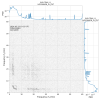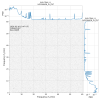We now have the new DARM offloading configuration up and running, and fully calibrated, so we can do a direct comparison of the old offloading (Old DARM) and new offloading (New DARM) using GDS-CALIB_STRAIN.
As pointed out by Elenna, the new DARM configuration improves the low frequency noise level. See first plot.
The old DARM configuration induced non-stationary noise at low frequency, as visible in the spectrogram in the second plot, and also in the whitened spectrogram in the third plot (where DARM is whitened with the median of the Old DARM configuration, to show at the same time the reduction in noise and the better stationarity).
Those same spectrograms also show that the new DARM configuration makes the low frequency noise more stationary.
Other comparison plots:
- DARM BLRMS at low frequency with old and new DARM
- ESD drive RMS
- scatter plot of DARM BLRMS vs ESD drive RMS, that shows a clear relation in old DARM
Finally, the last two plots show bicoherence of DARM with the ESD drive in old DARM and new DARM: nothing is visible in new DARM.
Great! This tripled the volumetric sensitivity to 500+500 M☀️ intermediate-mass black holes.









